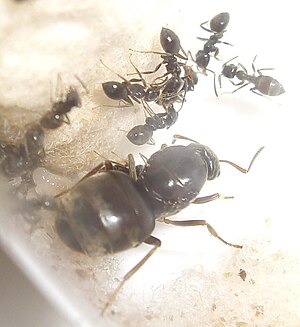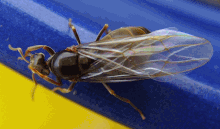Black garden ant
| Black garden ant | ||||||||||||
|---|---|---|---|---|---|---|---|---|---|---|---|---|

Black garden ant ( Lasius niger ), queen and workers |
||||||||||||
| Systematics | ||||||||||||
|
||||||||||||
| Scientific name | ||||||||||||
| Lasius niger | ||||||||||||
| ( Linnaeus , 1758) |
The black path ant ( Lasius niger ), also called matt black path ant , black garden ant or black-gray path ant , belongs to the genus of the path ants ( Lasius ) in the subfamily of scale ants (Formicinae ).

features
The workers are 3 to 5 millimeters long. The color varies between dark brown and black, the dense body hair is silvery, including some longer hair. In fact, the longer body hair is missing in the alien garden ant ( Lasius alienus ), from which it can hardly be distinguished. The sex animals swarm between June and September. The queens are 8 to 9 millimeters long, the males 3.5 to 4.5 millimeters long. The black garden ant is active between March and October.
distribution and habitat
The distribution area extends over Europe , Asia , Africa and North America . It is the most common ant in Central Europe . They can be found in habitats that are not too dry, on the edges of forests as well as in open landscapes.
Way of life
As a very adaptable animal, it also lives in gardens and cities, where it hides under stones, tree bark, in the lawn and in wall crevices and also invades houses.
nutrition
Food is sugary (mainly honeydew ) and proteinaceous substances (mainly insects ).
symbiosis
Black garden ants are aphidophilic ; That is, they like to live in symbiosis with myrmecophilic aphids , scale lice and root lice . The type of symbiosis is a trophobiosis , as the ants provide protection against food. They protect them from predators, often cover twigs close to the ground with protective cladding made from crumbs of earth or sand , and breed root lice in their own nests. In order to shorten the route, the lice are also placed on plants near the nest. Trophobiosis can also exist with the gall wasp Andricus symbioticus .
Nest building
The animals build their nest mounds a few centimeters high only from soil and around plants (for example blades of grass). This makes the building, which is not very stable, a little more durable, as the plants serve as supports for the structure.
Reproduction
The sex animals swarm out on warm midsummer days. The mating takes place in flight. The males die soon afterwards, the young queen throws off her wings and makes a nest. It closes in an underground chamber (claustral colony foundation). Here she lays the eggs and raises the first workers. Up to 25% of the colony is established by several queens ( pleometrosis ). All but one of the queens are usually eliminated shortly after the establishment phase by the workers or the dominant queen, and the colony becomes monogyny .
Others
- In terms of evolution, the species has probably existed almost unchanged for around 50 million years. The Lasius schiefferdeckeri , found by the thousands in the Eocene Baltic amber as one of the most common ants, is morphologically so similar to the recent Lasius niger that some authors consider it to be species-identical.
- L. niger is a popular species for keeping ants because it is robust, aggressive and interesting. A formicarium serves as a "living space" . The temperature must be adapted to the prevailing outside, in winter a hibernation is necessary, which occurs at around 6 ° C to 8 ° C.
swell
- Heiko Bellmann : bees, wasps, ants. Hymenoptera of Central Europe . Franckh-Kosmos, Stuttgart 1995, ISBN 3-440-09690-4
Individual evidence
- ^ W. Völkl, et al .: Chemical and tactile communication between the root aphid parasitoid Paralipsis enervis and trophobiotic ants: consequences for parasitoid survival. In: Experientia 52, No. 7, 1996, pp. 731-738. doi : 10.1007 / BF01925584
- ↑ K. Escherich: The relationships of the ants to non-social animals. In: K. Escherich (Ed.): Die Ameise , Eighth Chapter, Friedr. Viehweg & Sohn, Braunschweig 1917, p. 230ff. doi : 10.1007 / 978-3-322-98715-0_9 .
- ↑ Abe Yoshihisa: Trophobiosis between the Gall Wasp, Andricus symbioticus, and the Gall-Attending Ant, Lasius niger. In: Appl. Ent. Zool. 23, No. 1, 1988, 41-44. doi : 10.1303 / aez.23.41 (currently not available)
- ^ Sven Gisle Larsson: Baltic Amber - a Palaeobiological Study. - Entomograph, Vol. 1, Klampenborg (Denmark) 1978.

